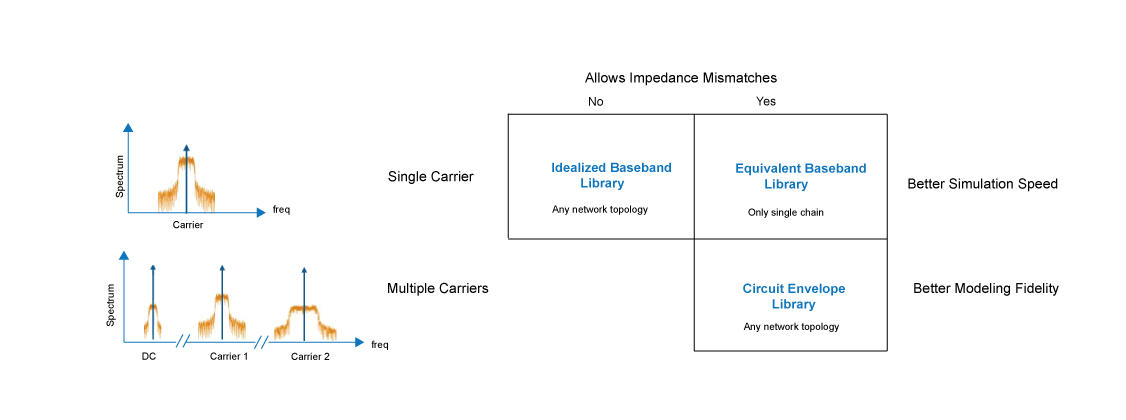Using RF Blockset for the First Time
Expected Background
Topics in the RF Blockset™ documentation assume that you are already familiar with:
Using MATLAB® to write and execute scripts and functions.
Using Simulink® to create and simulate block diagrams.
Circuit Envelope, Equivalent Baseband, and Idealized Baseband Features
RF Blockset software offers Circuit Envelope, Equivalent Baseband, and Idealized Baseband libraries to model RF networks. Each library represents a distinct simulation paradigm. For certain applications, one library can offer an advantage over another.
Use the Circuit Envelope Library for multicarrier simulation of RF networks with arbitrary topologies.
Use the Equivalent Baseband Library for single-carrier simulation of cascaded RF networks.
Use the Idealized Baseband Library for discrete-time simulation of RF networks without impedance mismatches.
You can also use this decision matrix to decide which library to use to design your RF systems. The Circuit Envelope library enables high-fidelity, multicarrier simulation of any network topology with impedance mismatches. The Equivalent Baseband library enables fast, discrete-time simulation of single-carrier single-chain systems with impedance mismatches. And the Idealized Baseband library enables fast, single-carrier simulation of perfectly matched networks with any network topologies.

All blocks from the Circuit Envelope and Equivalent Baseband libraries except Inport, Outport, Input Port, and Output Port blocks do not connect to each other. Therefore, to avoid redesigning your model later, choose which library to use based on your application. Consult this table for a summary of the features of the three libraries.
Summary of Features
| Feature | Circuit Envelope Library | Equivalent Baseband Library | Idealized Baseband Library |
|---|---|---|---|
| Connect directly to Simulink blocks | No, except the cross-domain blocks | No, except the cross-domain blocks | Yes |
| Support single-carrier simulation | Yes | Yes | Yes |
| Support multicarrier simulation | Yes | No | No |
| Support nonlinear elements | Yes | Yes | Yes |
| Support simulation of cascaded networks | Yes | Yes | Yes |
| Support simulation of networks with arbitrary topologies | Yes | No | Yes |
| Support signal probing between input and output | Yes | No | Yes |
| Support noise simulation | Yes | Yes | Yes |
| Support custom authoring | Yes | No | No |
| Support specification using network parameter data | Yes | Yes | Yes |
| Model input/output impedance mismatches | Yes | Yes | No |
| Generate C code with Simulink Coder™ | No | Yes | Yes |
| Support Rapid Accelerator Simulation Mode | Yes | Yes | Yes |
| Support Model Reference Accelerator Simulation Mode | Yes | Yes | Yes |
| Support Model Protection | Yes | Yes | Yes |
Note
Rapid Accelerator, Model Reference Accelerator, and Model Protection are not supported for a subset of circuit envelope blocks. For more information, see Enable Model Protection and Accelerator Modes in RF Blockset Models.
Understanding RF Blockset Environment
The RF Blockset environment comprises of interconnected blocks and algorithms that model an RF system. In the RF Blockset environment, all blocks fall into one of the three categories.
Blocks Operating Within RF Blockset Environment
These blocks contribute to the physical representation of an RF system. Most RF Blockset Circuit Envelope, Equivalent Baseband and Idealized Baseband library blocks fall into this category, including all blocks in the Elements and Sources sublibraries. For example, a Resistor block can model a source impedance or part of a matching network, and an Amplifier block can model a physical RF amplifier. Both these blocks model physical components.
Blocks Operating Between RF Blockset and Simulink Environments
These blocks, also called cross-domain blocks, provide an interface from an RF system to a larger design. The Inport, Outport, Input Port, and Output Port blocks fall into this category. For example, you can construct a signal using blocks from Communications Toolbox™ or DSP System Toolbox™ libraries, and you can input that signal into the RF Blockset environment using a RF Blockset Inport block. You can also input that signal into an RF chain using an RF Blockset Input Port block.
Environment Independent Block
The Configuration block manipulates the environment and determines the simulation configuration. To use this block, connect it to any part of the RF system. Because this block is not a part of the physical representation of the system, it has the same effect regardless of where you connect it.
To run models containing other RF Blockset blocks, you must connect a Configuration block to the RF Blockset environment.